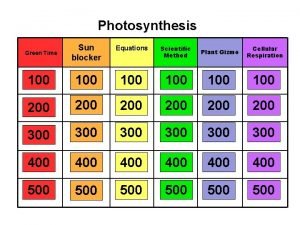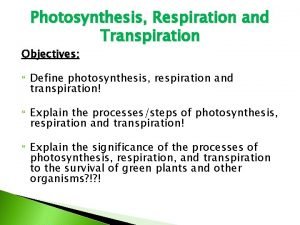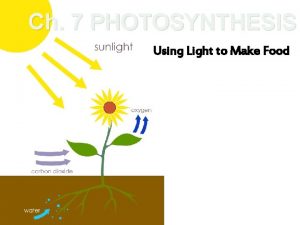Plants and Photosynthesis Lesson 10 Plants as food








- Slides: 8

Plants and Photosynthesis Lesson 10 - Plants as food Biology - Key Stage 3 Miss White 1

Name the 4 uses of glucose 1. 2. 3. 4.

Task 1. What is the name for the organism at the start of the food chain? 1. What is transferred up the food chain? 1. Name 2 uses of glucose 1. Describe how you would test for starch - Include the chemical used and the relevant colour changes

Prediction Fill in your table with your prediction Food Potato Carrots Biscuit Pasta Colour change of iodine

Independent Task 1. Describe what the results tell about the content of our staple foods. 2. Support your description with results from the starch test using iodine. 3. Explain why we see this result. Food Colour change of iodine Potato Brown to black Carrots Stayed brown Biscuit Brown to black Pasta Brown to black Keywords iodine, glucose, photosynthesis, plants, starch,

Quick check 1. Why are plants known as producers? 1. Name two other food sources sugars can be used to produce 1. Why are humans classed as omnivores?

Bee populations This graph shows the bee population between 1945 and 2005 Describe the pattern shown in the graph Source: Miss White

Task: Describe the role of plants in providing these conditions Use the photosynthesis equation to help you Condition for animal life Low levels of carbon dioxide Oxygen needed for respiration Availability of food How plants contribute to this
 The food that plants produce during photosynthesis is
The food that plants produce during photosynthesis is What raw materials does a plant need for photosynthesis
What raw materials does a plant need for photosynthesis Green plants make their own food by photosynthesis
Green plants make their own food by photosynthesis Objectives of photosynthesis
Objectives of photosynthesis Food chain is
Food chain is Unit 2 food food food
Unit 2 food food food Grazing food chain diagram
Grazing food chain diagram Chapter 7 photosynthesis using light to make food
Chapter 7 photosynthesis using light to make food Photosynthesis using light to make food
Photosynthesis using light to make food















